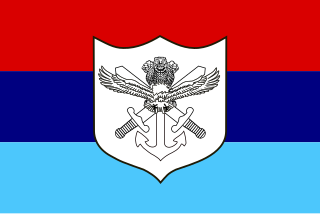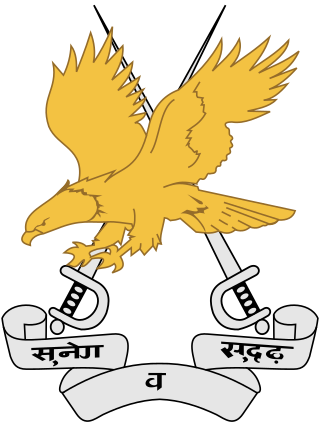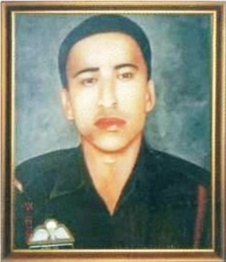
The Pakistan Armed Forces are the military forces of Pakistan. It is the world's sixth-largest military measured by active military personnel and consist of three formally uniformed services—the Army, Navy, and the Air Force, which are backed by several paramilitary forces such as the National Guard and the Civil Armed Forces. A critical component to the armed forces' structure is the Strategic Plans Division Force, which is responsible for the maintenance and safeguarding of Pakistan's tactical and strategic nuclear weapons stockpile and assets. The President of Pakistan is the Commander-in-Chief of the Pakistan Armed Forces and the chain of command is organized under the Chairman of the Joint Chiefs of Staff Committee (JCSC) alongside the respective Chiefs of staffs of the Army, Navy, and Air Force. All branches are systemically coordinated during joint operations and missions under the Joint Staff Headquarters (JSHQ).

The Indo-Pakistani war of 1947–1948, also known as the first Kashmir war, was a war fought between India and Pakistan over the princely state of Jammu and Kashmir from 1947 to 1948. It was the first of four Indo-Pakistani wars between the two newly independent nations. Pakistan precipitated the war a few weeks after its independence by launching tribal lashkar (militias) from Waziristan, in an effort to capture Kashmir and to preempt the possibility of its ruler joining India.

The Pakistan Navy (PN) is the uniform naval warfare branch of the Pakistan Armed Forces. The President of Pakistan is the Supreme Commander of the Navy. The Chief of the Naval Staff, a four-star admiral commands the navy. The Pakistan Navy operates on the coastline of Pakistan in the Arabian Sea and Gulf of Oman. It was established in August 1947, following the independence of Pakistan from the United Kingdom.

The insurgency in Jammu and Kashmir, also known as the Kashmir insurgency, is an ongoing separatist militant insurgency against the Indian administration in Jammu and Kashmir, a territory constituting the southwestern portion of the larger geographical region of Kashmir, which has been the subject of a territorial dispute between India and Pakistan since 1947.

The Pakistan Army, commonly known as the Pak Army is the land service branch and the largest component of the Pakistan Armed Forces. The president of Pakistan is the supreme commander of the army. The Chief of Army Staff (COAS), a four-star general, commands the army. The Army was established in August 1947 after Pakistan gained independence from the United Kingdom. According to statistics provided by the International Institute for Strategic Studies (IISS) in 2023, the Pakistan Army has approximately 560,000 active duty personnel, supported by the Pakistan Army Reserve, the National Guard and the Civil Armed Forces. Pakistan Army is the sixth-largest army of the world and the largest of the Muslim world.
Operation Python, a follow-up to Operation Trident, was the code name of a naval attack launched on West Pakistan's port city of Karachi by the Indian Navy during the Indo-Pakistani War of 1971. After the first attack during Operation Trident on the Port of Karachi, Pakistan stepped up aerial surveillance of its coast as the presence of large Indian Navy ships gave the impression that another attack was being planned. Pakistani warships attempted to outsmart the Indian Navy by mingling with merchant shipping. To counter these moves, Operation Python was launched on the night of 8/9 December 1971. A strike group consisting of one missile boat and two frigates attacked the group of ships off the coast of Karachi. While India suffered no losses, Pakistani fleet tanker PNS Dacca was damaged beyond repair, and the Kemari Oil Storage facility was lost. Two other foreign ships stationed in Karachi were also sunk during the attack.

India–Pakistan relations are the bilateral ties between the Republic of India and the Islamic Republic of Pakistan. The two countries have a complex and largely hostile relationship that is rooted in a multitude of historical and political events, most notably the partition of British India in August 1947.

The Garud Commando Force is the special forces unit of the Indian Air Force. It was formed in February 2004 and has a current strength of over 1500 personnel. The unit derives its name from Garuda, a Hindu God.
The Pakistan Rangers are a pair of paramilitary federal law enforcement corps' in Pakistan. The two corps are the Punjab Rangers and the Sindh Rangers. There is also a third corps headquarters in Islamabad but is only for units transferred from the other corps for duties in the federal capital. They are both part of the Civil Armed Forces. The corps' operate administratively under the Pakistan Army but under separate command structures and wear distinctly different uniforms. However, they are usually commanded by officers on secondment from the Pakistan Army. Their primary purpose is to secure and defend the approximately 2,200 km (1,400 mi) long border with neighbouring India. They are also often involved in major internal and external security operations with the regular Pakistani military and provide assistance to municipal and provincial police forces to maintain law and order against crime, terrorism and unrest. In addition, the Punjab Rangers, together with the Indian Border Security Force, participate in an elaborate flag lowering ceremony at the Wagah−Attari border crossing east of Lahore. The mutually-recognized India–Pakistan international border is different from the disputed and heavily militarized Line of Control (LoC), where the Pakistani province of Punjab adjoins Jammu and Kashmir and the undisputed international border effectively ends. Consequently, the LoC is not managed by the paramilitary Punjab Rangers, but by the regular Pakistan Army.

The Indian Armed Forces are the military forces of the Republic of India. It consists of three professional uniformed services: the Indian Army, Indian Navy, and Indian Air Force. Additionally, the Indian Armed Forces are supported by the Central Armed Police Forces, Indian Coast Guard and Special Frontier Force and various inter-service commands and institutions such as the Strategic Forces Command, the Andaman and Nicobar Command and the Integrated Defence Staff. The President of India is the Supreme Commander of the Indian Armed Forces but the executive authority and responsibility for national security is vested in the Prime Minister of India and their chosen Cabinet Ministers. The Indian Armed Forces are under the management of the Ministry of Defence of the Government of India. With strength of over 1.4 million active personnel, it is the world's second-largest military force and has the world's largest volunteer army. It also has the third-largest defence budget in the world. The Global Firepower Index report lists it as the fourth most-powerful military.

The Army Aviation Corps (AAC) is the youngest arm of the Indian Army, being formally designated on 1 November 1986. The Army Aviation Corps units are designated as Squadrons. Each squadron generally consists of two Flights. Reconnaissance (Recce) and Observation flights might be part of squadrons or operate independently. The latter do not have a parent squadron and are designated by an (I) in their name.

The Pakistan Army Special Service Group is the special operations forces of the Pakistan Army. They are also known by their nickname of "Maroon Berets" due to their headgear.

In the wake of heavy monsoon rain and flash floods in Jammu and Kashmir, the Indian Armed Forces were deployed in increasing numbers starting 2 September 2014 to conduct search, rescue, relief, relocation, humanitarian assistance and rehabilitation missions in Jammu and Kashmir. By 18 September, over 298,514 people were rescued from the various parts of Jammu and Kashmir by the Armed forces. The Jammu and Kashmir floods, the worst in a century according to Omar Abdullah, the Chief Minister of Jammu and Kashmir, paralyzed the state government. Omar Abdullah, responding to public criticism, told the media "I had no government" in the first few days following the floods, as "My secretariat, the police headquarters, the control room, fire services, hospitals, all the infrastructure was underwater." Adding "I had no cell phone and no connectivity. I am now starting to track down ministers and officers." The Jammu and Kashmir floods of 2014 have been blamed on heavy rainfall, about 8 inches (200mm) on 4 September alone, on climate change, unplanned and uncontrolled development, encroachment of river banks, lakes, ponds, and massive loss of wet lands, absence of local government flood forecasting system, and poor governance. The Armed Forces humanitarian assistance mission in response to the floods was named Mission Sahayata (assistances). Northern Command's humanitarian assistance to Civil authorities was named 'Operation Megh Rahat'. The Indian Army, Air Force, and the Navy, committed large resources to the assistance mission including over 30,000 troops, 15 engineer task forces, 84 Indian Air Force and Army Aviation Corps fixed wing transport aircraft and helicopters, naval commandos and rescue specialists, and Base Hospital, four field hospitals, over 106 medical detachments. "Operation Megh Rahat", ended on 19 September 2014, but "Operation Sadbhavna", the relief and medical assistance support, according to government press release, will continue in "close synergy with the civil administration and the police".

Paratrooper Sanjog Chhetri, AC was an Indian soldier and a recipient of the Ashoka Chakra, India's highest peace time military decoration.He was posthumously awarded the Ashoka Chakra for his actions during an Indian Army counterterrorism operation on 22 September 2002 while serving with the 9 Para. He is the youngest recipient of the Ashoka Chakra.

Operation Raahat was an operation of the Indian Armed Forces to evacuate Indian citizens and foreign nationals from Yemen during the 2015 military intervention by Saudi Arabia and its allies in that country during the Yemeni Crisis. The evacuation by sea began on 1 April 2015 from the port of Aden. The air evacuation by the Indian Air Force and Air India commenced on 3 April 2015 from Sana'a. More than 4,640 Indian citizens in Yemen were evacuated along with 960 foreign nationals from 41 countries. The air evacuation ended on 9 April 2015 while the evacuation by sea ended on 11 April 2015.
On 20 February 2016, 4 Lashkar-e-Taiba terrorists armed with AK-47 Assault rifles, UBGL, hand grenades, and explosives attacked a CRPF convoy on the main road linking Srinagar to Jammu, killing two police men and a civilian. The militants then took refuge in the government-run multi-story "Entrepreneurship Development Institute" in Pampore. Units of the Indian Army and Central Reserve Police Force cordoned off the building and launched a joint operation to evacuate civilians from the building. For Security forces, their main focus was to evacuate civilians to safety. Army and CRPF launched a joint operation with armored vehicles to evacuate 120 civilians from the building. The militants responded with automatic gunfire and hand grenades. During the ensuing battle, three soldiers from Indian Army lost their lives. Captain Pawan Kumar from 10 Para Special Forces, Captain Tushar Mahajan & Lance Naik Om Prakash from 9 Para Special Forces lost their life. Capt. Pawan Kumar from Army's 10 Para Special Forces unit lost his life on the first day during the firefight, a terrorist was also killed in the firefight. After the firefight part of the EDI building caught on fire.

Indian Army operations in Jammu and Kashmir include security operations such as Operation Rakshak, which began in 1990, Operation Sarp Vinash in 2003 and Operation Randori Behak in 2020. Other operations include humanitarian missions such as Operation Megh Rahat and operations with a social aim such as Operation Goodwill and Operation Calm Down. The Indian Army works in tandem with the other arms of the Indian Armed Forces and security forces in Jammu and Kashmir such as during Mission Sahayata or joint operations.

Indian Armed Forces in Jammu and Kashmir encompass the Indian Army, Navy and Air Force, tri-service units such as the Armed Forces Special Operations Division (AFSOD), and paramilitary organisations of the Central Armed Police Forces such as the Border Security Force, the Central Reserve Police Force, the Sashastra Seema Bal and the Indo-Tibetan Border Police. Each three wings of India's military have their special forces deployed in the region including Indian Army's Para SF, the Indian Navy MARCOS and the Indian Air Force's Garud Commando Force. Apart from this, there is the elite police anti-insurgency force in the region, the Special Operations Group, of the Jammu and Kashmir Police.

The Civil Armed Forces (CAF) are a group of nine paramilitary, uniformed organisations, separate and distinct from the regular "military" Pakistan Armed Forces. They are responsible for maintaining internal security, helping law enforcement agencies, border control, counter-insurgency and counter-terrorism, riot control, and anti-smuggling under the Ministry of Interior. They frequently operate alongside the Pakistani military in response to natural disasters. During times of war they can have their command transferred to the Ministry of Defence, and effectively combined to form a reserve force for the Pakistani military.















